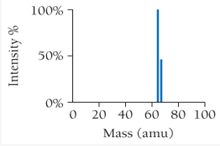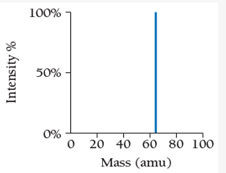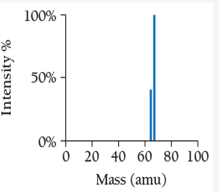
EBK CHEMISTRY
1st Edition
ISBN: 9780133888584
Author: Tro
Publisher: VST
expand_more
expand_more
format_list_bulleted
Concept explainers
Textbook Question
Chapter 1, Problem 11SAQ
Copper has an
Expert Solution & Answer
Want to see the full answer?
Check out a sample textbook solution
Students have asked these similar questions
Complete the following esterification reaction by drawing the structural
formula of the product formed.
HOH
HO
i
catalyst
catalyst
OH
HO
(product has rum flavor)
(product has orange flavor)
The statements in the tables below are about two different chemical equilibria. The symbols have their usual meaning, for example AG stands for the standard
Gibbs free energy of reaction and K stands for the equilibrium constant.
In each table, there may be one statement that is faise because it contradicts the other three statements. If you find a false statement, check the box next to t
Otherwise, check the "no false statements" box under the table.
statement
false?
AG"1
no false statements:
statement
false?
AG-0
0
InK-0
0
K-1
0
AH-TAS
no false statements
2
Complete the following esterification reactions by drawing the line formulas of the carboxylic acid
and alcohol required to form the ester shown.
catalyst
catalyst
catalyst
apricot fragrance
Chapter 1 Solutions
EBK CHEMISTRY
Ch. 1 - Which statement is true about matter? a) Matter is...Ch. 1 - A chemist mixes sodium with water and witnesses a...Ch. 1 - Two samples of a compound containing elements A...Ch. 1 - A compound containing only carbon and hydrogen has...Ch. 1 - Which concept was demostrated by Rutherford’s gold...Ch. 1 - A student re-creates Millikan’s oil drop...Ch. 1 - Prob. 7SAQCh. 1 - An isotope of an element contains 82 protons and...Ch. 1 - How many electrons are in the Cr3+ ion? 24...Ch. 1 - A naturally occurring sample of an element...
Ch. 1 - Copper has an atomic mass of 63.55 amu and two...Ch. 1 - Which sample contains the greatest number of...Ch. 1 - Explain this statement in your own words and give...Ch. 1 - Explain the main goal of chemistry.Ch. 1 - What are two different ways to classify matter?Ch. 1 - How do solids, liquids, and gases differ?Ch. 1 - Explain the difference between a pure substance...Ch. 1 - Explain the difference between an element and a...Ch. 1 - Explain the difference between a homogeneous and a...Ch. 1 - Describe the scientific approach to knowledge. How...Ch. 1 - Prob. 9ECh. 1 - What observations did Antoine Lavoisier make? What...Ch. 1 - What theory did John Dalton formulate?Ch. 1 - What is wrong with the expression, “That is just a...Ch. 1 - Summarize the history of the atomic idea. How was...Ch. 1 - Prob. 14ECh. 1 - State and explain the law of definite proportions.Ch. 1 - State and explain the law of multiple proportions....Ch. 1 - What are the main ideas in Dalton’s atomic theory?...Ch. 1 - How and by whom was the electron discovered? What...Ch. 1 - Explain Millikan’s oil drop experiment and how it...Ch. 1 - Prob. 20ECh. 1 - Describe Rutherford’s gold foil experiment. How...Ch. 1 - Describe Rutherford’s nuclear model of the atom....Ch. 1 - If matter is mostly empty space, as suggested by...Ch. 1 - List the three subatomic particles that compose...Ch. 1 - What defines an element?Ch. 1 - Explain the difference between Z (the atomic...Ch. 1 - Where do elements get their names?Ch. 1 - What are isotopes? What is percent natural...Ch. 1 - Describe the two different notations used to...Ch. 1 - Prob. 30ECh. 1 - Prob. 31ECh. 1 - Explain how a mass spectrometer works. What kind...Ch. 1 - Each shape represents a type of particle (such as...Ch. 1 - Using triangles to represent one type of atom and...Ch. 1 - Classify each substance as a pure substance or a...Ch. 1 - Classify each substance as a pure substance or a...Ch. 1 - Prob. 37ECh. 1 - Complete the table. Substance Pure or mixture Type...Ch. 1 - Determine whether each molecular diagram...Ch. 1 - Determine whether each molecular diagram...Ch. 1 - Classify each statement as an observation, a law,...Ch. 1 - Classify each statement as an observation, a law,...Ch. 1 - A chemist decomposes several samples of carbon...Ch. 1 - When astronomers observe distant galaxies, they...Ch. 1 - Prob. 45ECh. 1 - An automobile gasoline tank holds 21 kg of...Ch. 1 - Two samples of carbon tetrachloride are decomposed...Ch. 1 - Two samples of sodium chloride are decomposed into...Ch. 1 - The mass ratio of sodium to fluorine in sodium...Ch. 1 - Upon decomposition, one sample of magnesium...Ch. 1 - Two different compounds containing osmium and...Ch. 1 - Palladium forms three different compounds with...Ch. 1 - Prob. 53ECh. 1 - Sulfur and fluorine form several different...Ch. 1 - Which statements are consistent with Dalton’s...Ch. 1 - Which statements are inconsistent with Dalton’s...Ch. 1 - Which statements are consistent with Rutherford’s...Ch. 1 - Which statements are inconsistent with...Ch. 1 - A chemist in an imaginary universe, where...Ch. 1 - Imagine a unit of charge called the zorg. A...Ch. 1 - Which statements about subatomic particles are...Ch. 1 - Which statements about subatomic particles are...Ch. 1 - Write isotopic symbols in the form XA (e g., C-13)...Ch. 1 - Write isotopic symbols in the form ZAX for each...Ch. 1 - Determine the number of protons and the number of...Ch. 1 - Determine the number of protons and the number of...Ch. 1 - The amount of carbon-14 in ancient artifacts and...Ch. 1 - Uranium-235 is used in nuclear fission. Determine...Ch. 1 - Determine the number of protons and the number of...Ch. 1 - Determine the number of protons and the number of...Ch. 1 - Gallium has two naturally occurring isotopes with...Ch. 1 - Magnesium has three naturally occurring isotopes...Ch. 1 - The atomic mass of fluorine is 18.998 amu, and its...Ch. 1 - The atomic mass of copper is 63.546 amu. Do any...Ch. 1 - An element has two naturally occurring isotopes....Ch. 1 - An element has four naturally occuring isotopes...Ch. 1 - Bromine has two naturally occurring isotopes...Ch. 1 - Silicon has three naturally occurring isotopes...Ch. 1 - Use the mass spectrum of europium shown here to...Ch. 1 - Use the mass spectrum of rubidium shown here to...Ch. 1 - A 7.83-g sample of HCN contains 0.290 g of H and...Ch. 1 - The ratio of sulfur to oxygen by mass in SO2 is...Ch. 1 - Use the mass spectrum of lead shown here to...Ch. 1 - Use the mass spectrum of mercury shown here to...Ch. 1 - Nuclei with the same number of neutrons but...Ch. 1 - Fill in the blanks to complete the table. Symbol z...Ch. 1 - Silver is composed of two naturally occurring...Ch. 1 - To the right is a representation of 50 atoms of a...Ch. 1 - The ratio of oxygen to nitrogen by mass in NO2 is...Ch. 1 - Naturally occurring cobalt consists of only one...Ch. 1 - A 7.36-g sample of copper is contaminated with an...Ch. 1 - The ratio of the mass of O to the mass of N in...Ch. 1 - Naturally occurring magnesium has an atomic mass...Ch. 1 - A volatile liquid (one that readily evaporates) is...Ch. 1 - The diagram to the right represents solid carbon...Ch. 1 - Use triangles to represent atoms of element A and...Ch. 1 - Identify each statement as being most like an...
Knowledge Booster
Learn more about
Need a deep-dive on the concept behind this application? Look no further. Learn more about this topic, chemistry and related others by exploring similar questions and additional content below.Similar questions
- Show the saponification products of the following ester: You don't need to draw in the Na+ cation. catalyst, A catalyst, A catalyst, Aarrow_forwardWhat would happen if the carboxylic acid and alcohol groups were on the same molecule? In essence, the molecule reacts with itself. Draw the structure of the products formed in this manner using the reactants below. If two functional groups interact with one another on the same molecule, this is called an “intramolecular" (within one) rather than "intermolecular" (between two or more) attack. OH OH catalyst OH HO catalyst catalyst HO OHarrow_forwardQ3: Write in the starting alkyl bromide used to form the following products. Include any reactants, reagents, and solvents over the reaction arrow. If more than one step is required, denote separate steps by using 1), 2), 3), etc. H OH racemic OH OH 5 racemicarrow_forward
- Draw the Lewis structure of the SO3-O(CH3)2 complex shown in the bottom right of slide 2in lecture 3-3 (“Me” means a CH3 group) – include all valence electron pairs and formal charges.From this structure, should the complex be a stable molecule? Explain.arrow_forwardPredict all organic product(s), including stereoisomers when applicable.arrow_forwardQ5: Propose a reasonable synthesis for the following decalin derivative. using only decalin and alkanes of 3 or fewer carbons. Decalin H3C HO க CH3arrow_forward
- 2Helparrow_forwardplease add appropriate arrows, and tell me clearly where to add arrows, or draw itarrow_forwardWhat I Have Learned Directions: Given the following reaction and the stress applied in each reaction, answer the question below. A. H2(g) + Cl2(g) 2 HCl(g) Stress applied: Decreasing the pressure 1. What is the Keq expression? 2. What will be the effect in the number of moles of HCl(g)? 3. What will be the Equilibrium Shift or the reaction? B. Fe3O4(s) + 4 H2(g) + heat 53 Fe(s) + 4 H₂O(g) Stress applied: Increasing the temperature 1. What is the Keq expression?. 2. What will be the effect in the volume of water vapor collected? 3. What will be the Equilibrium Shift or the reaction? C. 4 NH3(g) + 5 O2(g) 4 NO(g) + 6 H2O(g) + heat Stress applied: Increasing the volume of the container 1. What is the Keq expression?. 2. What will be the effect in the amount of H₂O? 3. What will be the Equilibrium Shift or the reaction?arrow_forward
- Consider the solubility products (Ksp values) for the following compounds:SrSO4 (Ksp = 7.6 x 10−7), BaSO4 (Ksp = 1.5 x 10−9), SrCO3 (Ksp = 7.0 x 10−10), BaCO3 (Ksp = 1.6 x 10−9)Which anion is the harder base, CO32− or SO42−? Justify your answer.arrow_forwardQ1: a) Arrange the compounds in order of decreasing pKa, highest first. ОН ΟΗ ῸΗ дон ОН ОН CI Brarrow_forward(4 pts - 2 pts each part) A route that can be taken to prepare a hydrophobic (water-repellent) aerogel is to start with trichloromethylsilane, CH3SiCl3 as the silicon source. a. What is the chemical reaction that this undergoes to form a product with Si-OH groups? Write as complete of a chemical equation as you can. CI CI-SI-CH3 CI b. The formation of a byproduct is what drives this reaction - what is the byproduct (if you didn't already answer it in part (a)) and how/why does it form?arrow_forward
arrow_back_ios
SEE MORE QUESTIONS
arrow_forward_ios
Recommended textbooks for you
 Chemistry: Principles and PracticeChemistryISBN:9780534420123Author:Daniel L. Reger, Scott R. Goode, David W. Ball, Edward MercerPublisher:Cengage Learning
Chemistry: Principles and PracticeChemistryISBN:9780534420123Author:Daniel L. Reger, Scott R. Goode, David W. Ball, Edward MercerPublisher:Cengage Learning Chemistry: Principles and ReactionsChemistryISBN:9781305079373Author:William L. Masterton, Cecile N. HurleyPublisher:Cengage Learning
Chemistry: Principles and ReactionsChemistryISBN:9781305079373Author:William L. Masterton, Cecile N. HurleyPublisher:Cengage Learning General, Organic, and Biological ChemistryChemistryISBN:9781285853918Author:H. Stephen StokerPublisher:Cengage Learning
General, Organic, and Biological ChemistryChemistryISBN:9781285853918Author:H. Stephen StokerPublisher:Cengage Learning Chemistry: The Molecular ScienceChemistryISBN:9781285199047Author:John W. Moore, Conrad L. StanitskiPublisher:Cengage Learning
Chemistry: The Molecular ScienceChemistryISBN:9781285199047Author:John W. Moore, Conrad L. StanitskiPublisher:Cengage Learning Chemistry & Chemical ReactivityChemistryISBN:9781337399074Author:John C. Kotz, Paul M. Treichel, John Townsend, David TreichelPublisher:Cengage Learning
Chemistry & Chemical ReactivityChemistryISBN:9781337399074Author:John C. Kotz, Paul M. Treichel, John Townsend, David TreichelPublisher:Cengage Learning Chemistry & Chemical ReactivityChemistryISBN:9781133949640Author:John C. Kotz, Paul M. Treichel, John Townsend, David TreichelPublisher:Cengage Learning
Chemistry & Chemical ReactivityChemistryISBN:9781133949640Author:John C. Kotz, Paul M. Treichel, John Townsend, David TreichelPublisher:Cengage Learning

Chemistry: Principles and Practice
Chemistry
ISBN:9780534420123
Author:Daniel L. Reger, Scott R. Goode, David W. Ball, Edward Mercer
Publisher:Cengage Learning

Chemistry: Principles and Reactions
Chemistry
ISBN:9781305079373
Author:William L. Masterton, Cecile N. Hurley
Publisher:Cengage Learning

General, Organic, and Biological Chemistry
Chemistry
ISBN:9781285853918
Author:H. Stephen Stoker
Publisher:Cengage Learning

Chemistry: The Molecular Science
Chemistry
ISBN:9781285199047
Author:John W. Moore, Conrad L. Stanitski
Publisher:Cengage Learning

Chemistry & Chemical Reactivity
Chemistry
ISBN:9781337399074
Author:John C. Kotz, Paul M. Treichel, John Townsend, David Treichel
Publisher:Cengage Learning

Chemistry & Chemical Reactivity
Chemistry
ISBN:9781133949640
Author:John C. Kotz, Paul M. Treichel, John Townsend, David Treichel
Publisher:Cengage Learning
NEET Chemistry | Group 14 Carbon Family | Theory & Problem Solving | In English | Misostudy; Author: Misostudy;https://www.youtube.com/watch?v=enOGIrcHh54;License: Standard YouTube License, CC-BY



